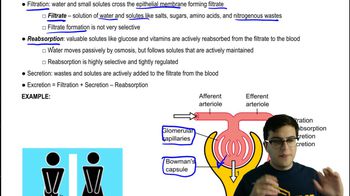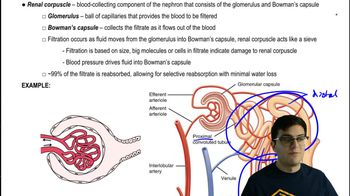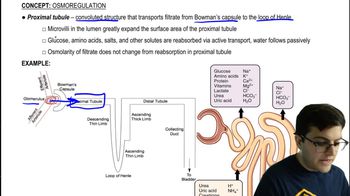Table of contents
- 1. Introduction to Biology2h 40m
- 2. Chemistry3h 40m
- 3. Water1h 26m
- 4. Biomolecules2h 23m
- 5. Cell Components2h 26m
- 6. The Membrane2h 31m
- 7. Energy and Metabolism2h 0m
- 8. Respiration2h 40m
- 9. Photosynthesis2h 49m
- 10. Cell Signaling59m
- 11. Cell Division2h 47m
- 12. Meiosis2h 0m
- 13. Mendelian Genetics4h 41m
- Introduction to Mendel's Experiments7m
- Genotype vs. Phenotype17m
- Punnett Squares13m
- Mendel's Experiments26m
- Mendel's Laws18m
- Monohybrid Crosses16m
- Test Crosses14m
- Dihybrid Crosses20m
- Punnett Square Probability26m
- Incomplete Dominance vs. Codominance20m
- Epistasis7m
- Non-Mendelian Genetics12m
- Pedigrees6m
- Autosomal Inheritance21m
- Sex-Linked Inheritance43m
- X-Inactivation9m
- 14. DNA Synthesis2h 27m
- 15. Gene Expression3h 20m
- 16. Regulation of Expression3h 31m
- Introduction to Regulation of Gene Expression13m
- Prokaryotic Gene Regulation via Operons27m
- The Lac Operon21m
- Glucose's Impact on Lac Operon25m
- The Trp Operon20m
- Review of the Lac Operon & Trp Operon11m
- Introduction to Eukaryotic Gene Regulation9m
- Eukaryotic Chromatin Modifications16m
- Eukaryotic Transcriptional Control22m
- Eukaryotic Post-Transcriptional Regulation28m
- Eukaryotic Post-Translational Regulation13m
- 17. Viruses37m
- 18. Biotechnology2h 58m
- 19. Genomics17m
- 20. Development1h 5m
- 21. Evolution3h 1m
- 22. Evolution of Populations3h 52m
- 23. Speciation1h 37m
- 24. History of Life on Earth2h 6m
- 25. Phylogeny2h 31m
- 26. Prokaryotes4h 59m
- 27. Protists1h 12m
- 28. Plants1h 22m
- 29. Fungi36m
- 30. Overview of Animals34m
- 31. Invertebrates1h 2m
- 32. Vertebrates50m
- 33. Plant Anatomy1h 3m
- 34. Vascular Plant Transport2m
- 35. Soil37m
- 36. Plant Reproduction47m
- 37. Plant Sensation and Response1h 9m
- 38. Animal Form and Function1h 19m
- 39. Digestive System10m
- 40. Circulatory System1h 57m
- 41. Immune System1h 12m
- 42. Osmoregulation and Excretion50m
- 43. Endocrine System4m
- 44. Animal Reproduction2m
- 45. Nervous System55m
- 46. Sensory Systems46m
- 47. Muscle Systems23m
- 48. Ecology3h 11m
- Introduction to Ecology20m
- Biogeography14m
- Earth's Climate Patterns50m
- Introduction to Terrestrial Biomes10m
- Terrestrial Biomes: Near Equator13m
- Terrestrial Biomes: Temperate Regions10m
- Terrestrial Biomes: Northern Regions15m
- Introduction to Aquatic Biomes27m
- Freshwater Aquatic Biomes14m
- Marine Aquatic Biomes13m
- 49. Animal Behavior28m
- 50. Population Ecology3h 41m
- Introduction to Population Ecology28m
- Population Sampling Methods23m
- Life History12m
- Population Demography17m
- Factors Limiting Population Growth14m
- Introduction to Population Growth Models22m
- Linear Population Growth6m
- Exponential Population Growth29m
- Logistic Population Growth32m
- r/K Selection10m
- The Human Population22m
- 51. Community Ecology2h 46m
- Introduction to Community Ecology2m
- Introduction to Community Interactions9m
- Community Interactions: Competition (-/-)38m
- Community Interactions: Exploitation (+/-)23m
- Community Interactions: Mutualism (+/+) & Commensalism (+/0)9m
- Community Structure35m
- Community Dynamics26m
- Geographic Impact on Communities21m
- 52. Ecosystems2h 36m
- 53. Conservation Biology24m
42. Osmoregulation and Excretion
Osmoregulation and Excretion
Problem 2c
Textbook Question
Textbook QuestionWhich of the following organisms would lose the most water by osmosis across its gills? a. marine bony fish b. shark c. freshwater fish d. freshwater invertebrate
 Verified step by step guidance
Verified step by step guidance1
Step 1: Understand the concept of osmosis. Osmosis is the movement of water molecules from an area of high concentration to an area of low concentration through a semi-permeable membrane.
Step 2: Understand the concept of osmoregulation in aquatic organisms. Aquatic organisms have to maintain a balance of water and salts in their bodies. This is achieved through osmoregulation, which is the process of maintaining salt and water balance (osmotic balance) across membranes within the body's fluids.
Step 3: Consider the environment of each organism. Marine bony fish live in saltwater, which has a higher concentration of salts than their body fluids. Sharks, also marine organisms, have a salt concentration in their bodies similar to that of seawater. Freshwater fish and invertebrates live in an environment with a lower concentration of salts than their body fluids.
Step 4: Apply the concept of osmosis to each organism. In marine bony fish, water tends to move out of their bodies into the surrounding seawater, causing them to lose water. Sharks, having a similar salt concentration to seawater, do not lose as much water. Freshwater fish and invertebrates, on the other hand, tend to gain water from their environment.
Step 5: From the above analysis, the marine bony fish would lose the most water by osmosis across its gills because it lives in an environment with a higher concentration of salts than its body fluids.
Recommended similar problem, with video answer:
 Verified Solution
Verified SolutionThis video solution was recommended by our tutors as helpful for the problem above
Video duration:
1mPlay a video:
Was this helpful?
Key Concepts
Here are the essential concepts you must grasp in order to answer the question correctly.
Osmosis
Osmosis is the movement of water molecules across a selectively permeable membrane from an area of lower solute concentration to an area of higher solute concentration. This process is crucial for maintaining cellular homeostasis and is particularly relevant in aquatic organisms, where the surrounding water's salinity can significantly affect water balance.
Recommended video:
Guided course

Osmosis
Salinity and Osmoregulation
Salinity refers to the concentration of salts in water, which influences the osmotic pressure experienced by aquatic organisms. Marine bony fish are typically in a hypertonic environment, leading to water loss through their gills, while freshwater fish are in a hypotonic environment, causing them to gain water. Organisms have adapted various osmoregulatory strategies to cope with these challenges.
Recommended video:
Guided course

Osmoregulation and Nitrogenous Waste
Gills and Water Exchange
Gills are specialized respiratory structures in aquatic organisms that facilitate gas exchange and also play a critical role in osmoregulation. In organisms like marine bony fish, gills allow for the diffusion of water and ions, which can lead to significant water loss in a saline environment. Understanding how gills function in different salinities is essential for predicting water loss through osmosis.
Recommended video:
Guided course

Gas Exchange and Breathing

 7:16m
7:16mWatch next
Master Osmoregulation and Nitrogenous Waste with a bite sized video explanation from Jason Amores Sumpter
Start learningRelated Videos
Related Practice


































































